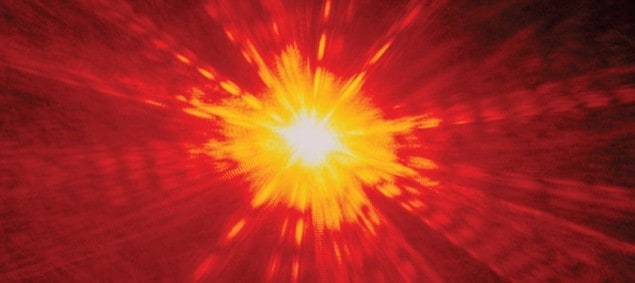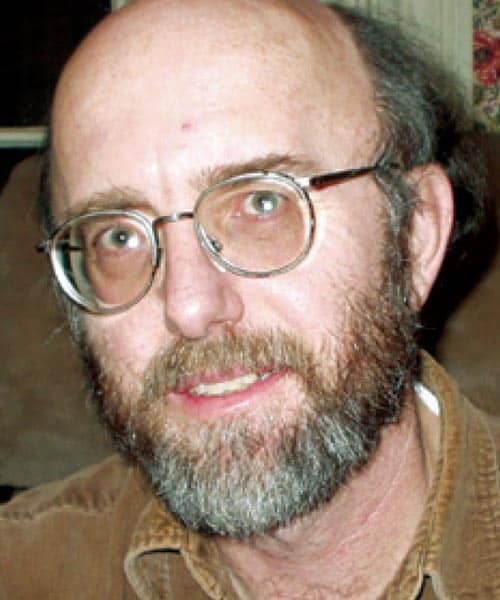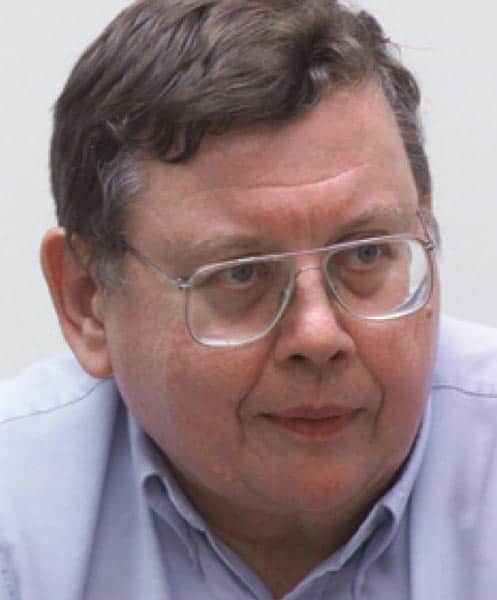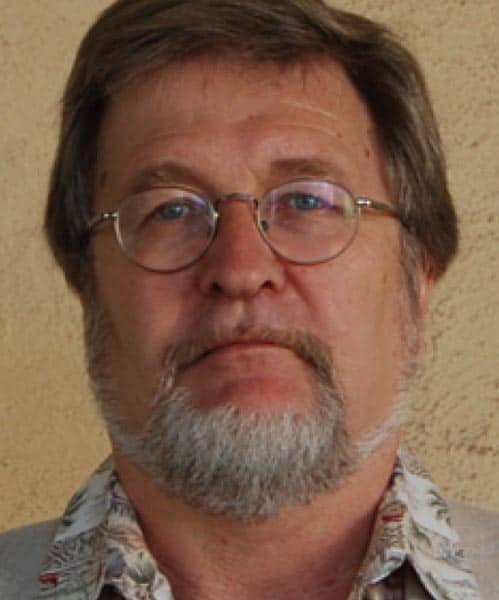From sharpening astronomical images and searching for gravitational waves to creating Bose–Einstein condensates and measuring the properties of DNA, the laser has had a tremendous impact on many different areas of science. Here, six experts recall how the laser has advanced their fields of interest – and speculate where the laser will take these areas next

Astronomy
Claire Max is an astronomer and director of the Center for Adaptive Optics at the University of California, Santa Cruz, US
We all know that turbulence in the atmosphere makes stars twinkle, but it also severely blurs telescope images. Newton realized this back in 1730, when he wrote in Opticks that “the Air through which we look upon the Stars, is in perpetual Tremor…The only Remedy is a most serene and quiet Air, such as may perhaps be found on the tops of the highest Mountains above the Grosser Clouds”.
Theoretically, telescopes of ever larger diameter should be able to resolve ever smaller features within astronomical images. But the blurring due to atmospheric turbulence is so severe that even today’s largest ground-based telescopes (8–10 m in diameter) cannot see any more clearly than the small 20 cm backyard telescopes used by amateur astronomers on weekend evenings.
To remedy this situation, astronomers have turned to adaptive optics, a technology that measures snapshots of the atmospheric turbulence and then corrects for the resulting optical distortion using a special deformable mirror (usually a small mirror placed behind the main mirror of the telescope). Since the turbulence is changing all the time, these measurements and corrections must be done hundreds of times a second.
Early adaptive-optics systems used light from a bright star to measure the turbulence. However, most objects of astronomical interest do not have bright stars sufficiently close by, and hence the sky coverage of adaptive optics was quite limited. Then, in the early 1980s, astronomers realized that they could use a laser to make an artificial “star” as a substitute. This insight greatly extended the reach of adaptive-optics systems, since lasers could be pointed in the direction of any observing target in the sky. In the past five years these laser “guide star” adaptive-optics systems have really come to fruition, to the point where today every major 8–10 m telescope sports its own laser beacon.
The lasers used in these beacons have respectable average powers of about 5–15 W (a typical laser pointer, in contrast, has a power of less than 1 mW). Indeed, federal regulations require US observatories to turn them off whenever aircraft approach; observatories also file their observing plans in advance with Space Command to avoid hitting sensitive space assets.
Two types of laser predominate. The first is a custom-built system that is tuned to the yellow 589 nm resonance line of neutral sodium, creating a guide star at an altitude of about 95 km by exciting naturally occurring sodium atoms in the Earth’s upper atmosphere. The second type is tuned to green or even ultraviolet wavelengths and uses Rayleigh scattering of atmospheric molecules and particulates to create a guide star at an altitude of 15–20 km. The advantage of green and ultraviolet lasers is that they are commercially available, making them much cheaper to use than adaptive-optics systems that exploit yellow light.
Thanks to laser guide-star adaptive optics, today’s 8–10 m telescopes have better spatial resolution at infrared observing wavelengths than the Hubble Space Telescope, simply because of the larger size of their mirrors. Proposed giant telescopes, such as the Thirty Meter Telescope, the Giant Magellan Telescope and the European Extremely Large Telescope, all plan to use multiple laser guide stars at the same time. This will allow astronomers to measure, and correct for, the turbulence in the entire 3D column of air above the telescope. These multiple-laser systems will use the techniques of tomography – similar to those used in medical imaging’s computerized axial tomography (CAT) scans – to reconstruct the turbulence profile, enabling adaptive-optics correction over much wider fields of view than are available today.
Atomic physics
William D Philips is a physicist at the National Institute of Standards and Technology (NIST) in Gaithersburg, Maryland, US. He shared the 1997 Nobel Prize for Physics with Claude Cohen-Tannoudji and Steven Chu for cooling and trapping atoms with laser light
In the early 1970s I was a young graduate student in Dan Kleppner’s research group at the Massachusetts Institute of Technology, working on a thesis that involved making precision measurements with a high-magnetic-field hydrogen maser (masers were the microwave precursors to the laser, which was originally called an “optical maser”). Kleppner and Norman Ramsey had invented a low-field version of the hydrogen maser more than a decade earlier, and the high-field version was producing unprecedentedly accurate measurements of magnetic moments in atoms – a sort of zenith for this kind of atomic physics.
But then came a new development that would change the direction of work in Dan’s lab, in my career and in atomic physics as a whole: the first continuous-wave, commercial, tunable dye lasers. The lasing medium in these devices was an organic dye that lased over a far wider range of wavelengths than, for example, a helium–neon laser, where the gain medium is an atomic gas. The introduction of these devices meant that even those who were not experts in laser design and construction could, by tuning a laser to an atomic-resonance transition, explore a new domain of atomic manipulation where coherent light was the key tool.
Eager to play with these new toys, I asked Dan to suggest an additional thesis experiment using lasers. He agreed, and suggested that I study collisions of optically excited sodium atoms. I began to build the apparatus. Other students and postdocs in the group started new experiments as well. Each issue of the research journals brought an increasing number of laser-related papers, and each conference saw reports of new laser experiments.
The excitement of that time was palpable. New ideas and new experiments popped up everywhere. In 1978 I was inspired by Dave Wineland’s demonstration of laser cooling of ions at the National Bureau of Standards (now NIST) in Boulder, Colorado, and by an idea from Art Ashkin at Bell Laboratories to slow and trap a beam of sodium atoms. Later that year, when I went to the bureau’s labs in Gaithersburg, Maryland, I took my thesis apparatus with me and began to work on laser cooling and trapping of sodium.
For me, the excitement I felt in the 1970s in Dan’s lab has never waned. New kinds of lasers with different wavelengths, ever shorter pulse lengths, ever higher powers, ever narrower spectral widths and ever better stability have all made possible new kinds of experiments. Laser cooling of many more types of atoms and ions, plus giant cold molecules, atomic clocks ticking at optical frequencies, and non-classical states of light are just some of the paths into which lasers have led atomic, molecular and optical (AMO) physics.
Moreover, lasers have allowed AMO physicists to realize Bose–Einstein condensation, to create optical lattices and to study ultracold Fermi gases. Each of these has deepened the connections between AMO and condensed-matter physics. It may be that lasers and cold atoms will help to elucidate some of the outstanding problems in condensed matter, such as the origins of high-temperature superconductivity and the nature of fractional-quantum-Hall states that are useful for quantum computing.
Ever since they first became available, lasers have invigorated and reinvigorated atomic physics, and the adventure shows no signs of stopping.
Biophysics
Steven Block is a biophysicist at Stanford University, California, US
Over the past 10 years, it has become possible to do experiments in biophysics that were previously just pipe dreams. For example, I work in a field known as single molecule biophysics. In this area, the challenge is to study the molecules of life – the proteins, nucleic acids, carbohydrates and other chemicals that make us up – literally one molecule at a time. This is not easy to do, because all biomolecules are much too small to be seen using, say, a conventional microscope. Nonetheless, we are finding that they can be manipulated and measured, and the techniques that are involved in doing this often require lasers.
One technique that my lab has helped to pioneer is known as “optical tweezers”. The idea behind optical tweezers is that you can use the radiation pressure supplied by an infrared laser beam to capture and manipulate small materials – including individual proteins and nucleic acids – and move them around under a microscope. To do this, we hook tiny microscopic beads up to molecules such as DNA. Then we can use optical tweezers and optical traps to “hold onto” these beads and exert very tiny, controlled forces on the DNA molecules.
The lasers that we use for this have some pretty extraordinary properties – they are not like the laser in a laser pointer or in your CD player. We need to be able to hold a laser beam stably in space to within the diameter of a hydrogen atom, or about 1 Å, for several seconds at a time. This is because the base pairs in a DNA molecule are only separated by about 3.5 Å, and one of the things we are interested in studying is how the enzyme RNA-polymerase, which “reads” the genetic code, moves as it climbs the DNA ladder one base pair at a time.
It is amazing that we can literally watch this happen, and it all depends on being able to shine laser light on the enzyme, scatter that light and measure displacements that are accurate down to an angstrom. We are constantly looking for lasers with higher power in single modes and better stability properties. Some of the new generation of diode lasers are now reaching the point where they can be used for these experiments, but for the most part they have not made it out of the lab yet. It will be very interesting once they do.
Defence
Jeff Hecht is a freelance science and technology writer based in Auburndale, Massachusetts, US, who has covered laser weapons since 1980
High-energy laser weapons – long the stuff of science fiction – have recently reached a turning point. But it is not the one you would expect if you saw news clips of a laser-armed Boeing 747 shooting down a target missile in February this year. Instead, the US military is planning to concentrate on thwarting attacks from short-range targets such as rockets, mortars and artillery shells.
Modern laser weaponry dates from about 1980, when the main goal was to develop high-energy lasers capable of destroying missiles launched hundreds or thousands of kilometres away. Indeed, US President Ronald Reagan’s “Star Wars” programme spent billions on plans for orbiting laser battle stations. But tough technology problems and the end of the Cold War changed the requirements. The result was the Airborne Laser (ABL): a Boeing 747 equipped with a megawatt chemical oxygen–iodine laser and designed to shoot down missiles launched by a “rogue state”.
But in May 2009, US defence secretary Robert Gates reported that the ABL (long plagued by budget and deadline overruns) had a lethal range of less than 140 km – far short of the planned minimum of 200 km. So, after the current round of tests (conducted at an undisclosed shorter range), efforts to reach megawatt powers will start again with lasers that use diode-pumped alkali-metal vapours. Lasers of this type currently emit just tens of watts but may eventually offer a better power-to-size ratio than the ABL.
Until those plans get off the ground – if they ever do – the bold new future of laser weapons will be solid-state lasers that emit 100 kW or more in a steady or repetitively pulsed beam. It has already been demonstrated that kilowatt-class lasers can detonate unexploded ordnance left on the battlefield by illuminating it from a safe distance. The hope is that lasers in the 100–400 kW range could also destroy rockets, mortars and shells at distances of up to a few kilometres. The close range of these targets would greatly ease beam-propagation problems that hamper laser-based missile-defence systems. Moreover, by detonating explosives in the air with laser heating, rather than firing projectiles at them, laser-based weapons could reduce “collateral damage” to friendly soldiers and non-combatants.
In March 2009 US defence giant Northrop Grumman reported continuous emission of more than 100 kW for five minutes from a laboratory diode-pumped laser. This February, Textron Systems reached the same goal with its own design. These are by far the highest continuous powers achieved in a solid-state laser. The next step will be to engineer a 100 kW laser that works on ships, trucks and planes. The US Army is moving Northrop Grumman’s device to the High Energy Laser System Test Facility at the White Sands Missile Range, New Mexico, where it is planning to try out a mobile version installed in a heavy battlefield truck. Another defence agency, DARPA, is building a lightweight 150 kW solid-state laser for use in fighter planes, while the US Navy is planning tests of similar lasers at sea.
The lasers used in all these projects mark a radical departure in laser-weapon design. Earlier weapon-class lasers were chemically fuelled, but commanders did not want them on the battlefield because handling chemical fuels posed major logistical issues. They also wanted lasers that could be powered by diesel generators. But other formidable challenges remain, including damage to the laser itself, the need to operate in a dirty battlefield environment and the expected high cost of the devices.
Bagging a few test rockets should be easy. Engineering mobile lasers that work reliably in messy places where people are shooting at them is a much tougher problem. We will probably see prototypes blasting targets out of the sky within a few years, but do not expect battlefield deployment until the 2020s at the earliest.
Free-electron lasers
John Madey is director of the FEL Laboratory at the University of Hawaii, US, and contributed to the development of free-electron lasers
Like all lasers, free-electron lasers (FELs) rely on the principle of stimulated emission to amplify a beam of light as it passes through a region of space. In other words, as electrons move from a high- to a low-energy state, they emit photons of light all at the same wavelength and all moving in the same direction. But unlike the transitions between bound electronic states in other lasers, FELs exploit another of Einstein’s key discoveries – special relativity – to provide tunable electromagnetic radiation from a beam of relativistic free electrons as they move through a spatially periodic transverse magnetic field.
According to special relativity, the electrons perceive such a field as an intense travelling wave in their rest frame, with a wavelength reduced in proportion to their kinetic energy. Photons scattered by the electrons from this pulse in the direction of their motion are reduced in wavelength once again when viewed from the laboratory frame. As a result, electrons with a kinetic energy of 50 MeV emit near-infrared radiation when moving through a field with a period of 2 cm. Light of longer and shorter wavelengths can be created by simply varying the energy of the electrons. FELs can readily provide laser light with about 1% of the instantaneous power of the electron beam – megawatts or more – and their pulse lengths can vary from less than a picosecond to full continuous-wave operation. Exceptional phase coherence is also attainable through the use of suitable interferometric resonator systems.
Serious efforts to explore the possible applications of FELs began shortly after colleagues and I at Stanford University successfully demonstrated the first optical-wavelength FEL amplifiers and oscillators in 1974 and 1976, respectively. The focus since then has been on using FELs to do things that are tricky to pull off by other means. Perhaps the best known application is to generate tunable, high peak power, coherent, femtosecond X-ray pulses at energies above 1 keV to carry out time-resolved structural and functional studies of complex individual and interacting molecules. The first such X-ray FEL is now in operation at the SLAC National Accelerator Laboratory in the US, with the European X-ray Free-Electron Laser due to come online at the DESY lab in Germany in 2014.
Even for applications where other types of lasers might be adequate, the big advantage of FELs is that they are so flexible. FELs have therefore proved invaluable in carrying out exploratory research when the requirements of a particular application have not yet been determined or when a research team does not have the time or money to develop a new specialized laser system needed to support the application. The short-pulse, high-peak-power, third-generation FELs, which were pioneered in the 1980s, have been particularly useful for developing new surgical techniques and for exploring the energy levels, band structure and mobility of electrons and holes in new electronic and optical materials, without having to worry about longer probing laser pulses damaging the material.
The more recently developed high-average-power FEL systems have extended these capabilities to include research on possible laser applications for industrial-scale materials processing. Of at least equal significance are the improvements in remote sensing for climate-change research made possible by the broad tunability, high peak power, and exceptional spatial and temporal coherence offered by FELs at visible and infrared wavelengths.
There are, however, a few clouds on the horizon for FEL research. Historically, such research has mainly taken place at a handful of small and mid-sized university and government labs in the US, Europe and Asia. A recent transition to larger national labs has brought many scientific advances, but also runs the risk of making both the science and the technology less accessible to university scientists, who may be based far away from large central facilities. It will, therefore, be critical to ensure that the customer and support base for the technology remains aware of the FEL’s smaller-scale applications, not just the signature high-power and short-wavelength ones.
Finally, there are concerns that the suppliers of FEL-supporting technologies – including high-power microwave, ultrahigh vacuum and special optical materials – may not be able to continue these product lines, given the decreasing industrial markets for them. Wise governments should take the steps needed to ensure that the know-how on which these critical national capabilities rely is not lost.
Gravitational waves
Eric Gustafson is at the California Institute of Technology, US, and leads the instrument-science group of the LIGO gravitational-wave observatory
Often referred to as “ripples in space–time”, gravitational waves are generated during extremely violent astrophysical events in which the velocities of objects such as neutron stars or black holes change by substantial fractions of the speed of light over a very brief period of time. Detecting such waves is a challenging task because, for ground-based detectors, these changes in velocity occur on timescales between a fraction of a millisecond and a few tens of milliseconds. Measuring these tiny fluctuations in the curvature of space–time requires the use of very sensitive laser interferometers, in which beams of light travel down the perpendicular arms of the device, bounce off mirrors at the far end of each arm and then return to interfere with one another. The idea is that a passing gravitational wave should change the interference pattern in a characteristic way.
As laser technology has evolved, the lasers used in gravitational-wave experiments have changed with it. The first interferometric experiment designed to detect these waves, built by Robert Forward at California’s Hughes Research Laboratory in the early 1970s, used a 75 mW helium–neon laser and was about the size of a chessboard. Forward reached an impressive sensitivity with this device, measuring the smallest vibrational displacement that had been detected with a laser to date: 1.3 × 10–14 m Hz–1/2 – equivalent to measuring changes of less than 2 mm in the distance from the Earth to the Sun. However, the poor power-scaling properties of the helium–neon laser meant it did not have a future in gravitational-wave interferometry beyond table-top experiments.
During the 1980s, several groups around the world built interferometers in ultra-high-vacuum systems, with their optics suspended to isolate them from ground noise. These experiments were between one and a few tens of metres in size and used argon-ion lasers, which operate at a wavelength of 514 nm and output several watts of power. Such interferometers were usually designed to study specific problems in gravitational-wave interferometry, such as comparing different optical configurations, finding ways to control the suspended optics and characterize noise in subsystems such as mirrors, and developing length and alignment control signals for the suspended optics.
Unfortunately, the plasma tubes used in argon-ion lasers, along with the cooling water they require, produce high levels of laser-frequency noise. What is more, the relatively short lifetimes of these tubes made them impractical for use in an observatory. Finally, the power output of the lasers – while higher than a helium–neon laser – was short of the hundreds of watts that more advanced detectors were understood to require, thanks to the fact that at high frequencies the detector sensitivity is limited by shot noise.
In the 1990s, as the current group of kilometre-scale observatories (LIGO in the US, VIRGO in Italy and GEO in Germany) were being planned and built, diode-pumped solid-state lasers became available. These lasers not only had much lower levels of frequency noise than argon-ion lasers, but also the potential to produce much higher power. Initially, their maximum power output was about 10 W, but improved diode-pumped lasers and the use of injection-locked power oscillators or master-oscillator power-amplifier configurations made 100 W-class lasers possible for a new generation of interferometers. These new interferometers will be deployed over the next few years at LIGO and VIRGO, and will use 200 W lasers. Meanwhile, GEO will use a squeezed-light technique to produce better shot-noise performance at lower laser power. For space-based instruments such as the Laser Interferometer Space Antenna (LISA), diode-pumped solid-state lasers were selected not for their high power potential but for their very high efficiency and reliability, characteristics that are especially important for a space-based mission.
It is not clear exactly what lasers or wavelengths will be required for future ground-based detectors. We may see slightly longer wavelengths selected that can be used with new mirror-substrate materials that are opaque at 1064 nm; equally well, we might see shorter wavelengths that allow us to use thinner mirror coatings, thus reducing the thermal noise produced. It is possible that as researchers begin to look for the “right” wavelength to optimize sensitivity, we will find that we need wavelengths that can only be produced via the nonlinear frequency conversion of solid-state lasers – and so our choice of lasers may continue to evolve.
• See more interviews with laser experts on our multimedia pages.









